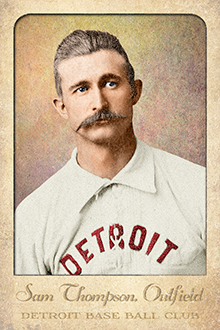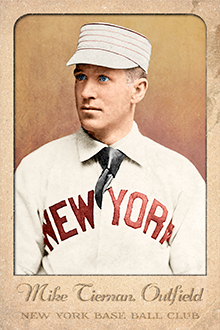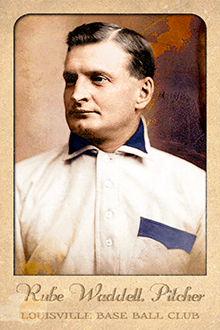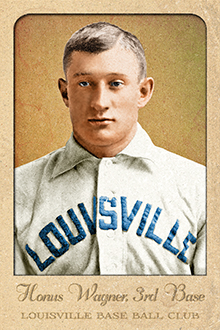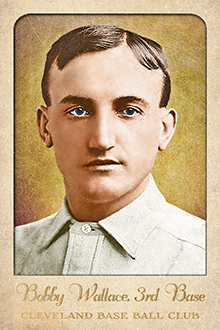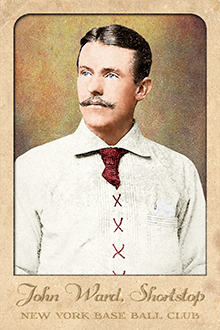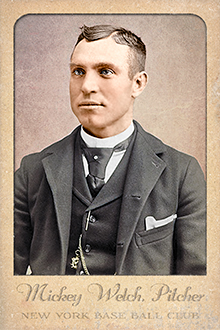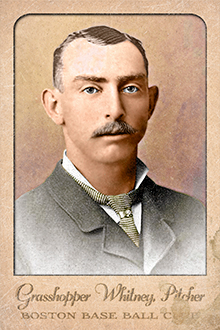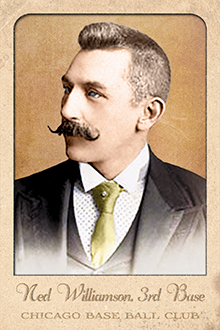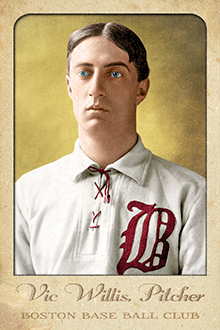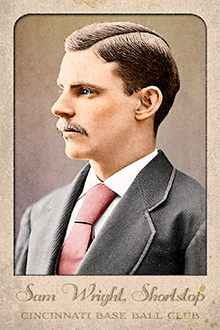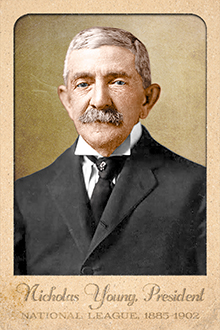- Series: Pioneer Portraits II: 1875-1899
- City: Brooklyn
- Team: Grays (AA)
- League: American Association
William H. Terry (1864-1915) was the first pitcher in the MLB history of the Brooklyn franchise and went on to win 197 games in his 14 year career. He won 20+ 4x. Threw 2 no-hitters and led the Bridegrooms to the ’89 AA title with 22 wins, then led them to the NL title in ’90 with 26 wins.
- Surrendered all 4 of Ed Delahanty’s HRs but won the game 9-8 on 7/13/96
- Adoring fans gave him his nickname, reflecting both his appealing appearance and character
- Series: Pioneer Portraits II: 1875-1899
- City: Detroit
- Team: Wolverines
- League: National League
- Hall: National Baseball Hall of Fame
“Big Sam” (1860-1922). An outfielder over 15 seasons for 3 different teams, Thompson was one of the great hitters of the 19th century. Sam was the 1st player with 20 steals & 20 HRs in a season. In 1894, he was one of 4 Philly OFs to hit over .400.
- His 61 RBI in 1 month is a record
- Only 19th c. player to amass 150 RBI in a season & he did it 2x
- .923 RBI/AB ranks 1st all-time
- Back problems shortened career; returned after 10 yrs to play 8 gms for Detroit in 1906
- Elected to hall of Fame: 1974
- Series: Pioneer Portraits II: 1875-1899
- City: New York
- Team: Giants
- League: National League
Michael Joseph Tiernan (1867-1918) overcame early miscues (a still-MLB-record 5 errors in a game & giving up a 10-run 10th inning in relief) to become a model of stability and decorum for the NY Giants, playing exclusively for them his entire 13-yr career. His bat trumped all else. “Silent Mike” was 4th in 19th Century HRs and batted .311 lifetime.
- Tiernan’s bat was key to the NY triumphs in the ’88-89 “world series”
- His outstanding year in ’91 silenced any animosity felt by returning teammates who had formed the ill-fated Players’ League
- Series: Pioneer Portraits II: 1875-1899
- City: New York
- Team: Giants
- League: National League
Ledell Titcomb (1866-1950). A pitcher for 5 professional seasons, Titcomb won a total of 30 games in his career while playing for 4 different clubs: Philadelphia Quakers, Philadelphia Athletics, New York Giants & Rochester Broncos. His best season was 1888, when he went 14-8 with a 2.24 ERA and 22 complete games for the New York Giants.
- Threw a no-hitter against the Syracuse Stars while pitching for the Rochester Broncos: 9.15.90
- Series: Pioneer Portraits II: 1875-1899
- City: Philadelphia
- Team: Quakers
- League: National League
William Miller Vinton (1865-1893) played two ML seasons in Philadelphia, debuting with the Quakers in 1884 and finishing the next year with the Athletics. He had a 17-19 won-lost record but a fine ERA of 2.46. Vinton returned to his beloved Yale University, ending his big league career.
- Continued to pursue minor league baseball in New England and then Minnesota
- Got his degree from Yale in 1888 but died at age 29
- Series: Pioneer Portraits II: 1875-1899
- City: Louisville
- Team: Colonels
- League: National League
- Hall: National Baseball Hall of Fame
George E. Waddell (1876-1914) was one of the premier pitchers in MLB history and also a man-child who’d leave the dugout and chase a fire truck. His titanic struggles with Cy Young made for the greatest pitching duels of all time. Connie Mack described his curve as the “fastest and deepest I’ve ever seen.”
- Waddell’s perplexing personal and social problems led to a shortened career and life
- Driven to distraction, Mack sold Rube to the Browns for the ’08 season, his last hurrah
- Elected to Hall of Fame: 1946
- Series: Pioneer Portraits II: 1875-1899
- City: Louisville
- Team: Colonels
- League: National League
- Hall: National Baseball Hall of Fame
Johannes Peter Wagner (1874-1955) was, simply, the greatest shortstop who ever played the game. The Pittsburgh icon was among the first five selections to Cooperstown in 1936 in recognition of overall prowess afield, at bat and on base unparalleled in baseball. Even his closest rival for “All-Time Best” honors, Ty Cobb, said Honus was “maybe the greatest star ever to take the diamond.” Badgered mercilessly by ‘Nuf Ced’ McGreevy’s Royal Rooters in the ’07 Series with Boston, Wagner was deeply wounded by his mediocre performance. He achieved some vindication 2 years later, leading the Pirates over Cobb’s Tigers.
- Space doesn’t allow a fair summary of Wagner’s hitting records. A marvel at the plate.
- Was a Pirates’ coach for 39 years, mentoring several future Hall of Famers
- Elected to Hall of Fame: 1936
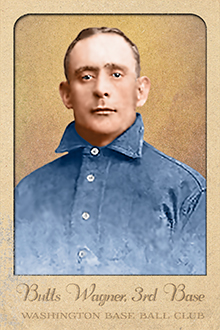
- Series: Pioneer Portraits II: 1875-1899
- City: Washington, D.C.
- Team: Senators
- League: National League
Albert Wagner (1871-1928) followed his kid brother Johannes (Honus) into the big leagues in 1898. The Pittsburgh native got his professional start in Steubenville of the Interstate League in 1895 when he was already 23. He moved to the Warren, PA entry in the Iron and Oil League the same season and later played infield and some outfield for the Canton Deubers and Wheeling Nailers back in the Interstate League. Butts then moved up to the Eastern League's Toronto Canadians/Canucks for the 1896-97 campaigns before getting his shot in MLB with the NL's Senators. His best game came after Washington dealt him to the Brooklyn Bridegrooms later in the '98 season. Wagner hit his only home run, doubled and scored three times in a 9-5 win on July 4. Honus, two years Butts' junior, had begun with the same Steubenville squad in 1895 after Al urged the manager to give him a tryout. Both Wagner boys had been barbers. Honus and Butts parted company the same year when the shortstop-for-the-ages moved on to the Michigan State League and a call-up in '97 to the Louisville Colonels and a National League career in baseball's stratosphere. Al returned to Pittsburgh and his barber chair.
- Butts' “career” stats included a .226 average in 74 MLB games
- However modest Butts' numbers, he can be rightly regarded as an all-time great scout
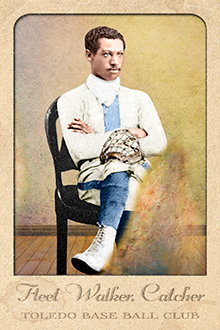
- Series: Pioneer Portraits II: 1875-1899
- City: Toledo
- Team: Blue Stockings
- League: American Association
Moses Fleetwood Walker (1857-1924) was likely not the first African-American to play major league baseball. For that distinction, historians have made a case for William Edward White, who played a game with the Providence Grays on June 21, 1879. Subbing for injured first baseman Joe Start, Bill White hit a single in four at bats, stole two bases, scored a run and recorded 12 putouts without an error, contributing to a 5-3 win for the title-bound Grays and a 19 year old pitcher named John Montgomery Ward. By the next game, White had been replaced at the position by regular right fielder and Hall of Famer Jim O’Rourke, who continued to man first base until Start returned. The historic event established a one game career in the major leagues for Bill White that predates Fleet Walker’s appearance by five years.
Fleet Walker became the second African-American major leaguer when he played for the Toledo Blue Stockings of the American Association in 1884. Toledo’s star pitcher was Tony Mullane, who considered Fleetwood “the best catcher I ever worked with.” Sadly, Mullane succumbed to the bigotry of his own and his day and, despite the negative consequences his maladaptive behavior bequeathed his team, repeatedly crossed Walker up by ignoring his signs. Mullane’s dangerous deceit led to a series of injuries for Fleetwood, including a season ending broken rib. Despite the difficulties and indignities, Fleet hit .263 on the year, which was a few ticks higher than league average.
Toledo went 46-58 in 1884, finished 8th in the league and folded at the end of the season. The graceful and talented Walker returned to minor league ball in 1885 and, when his playing days were past, led a noble life as an inventor, author and educator.
- Moses’ brother, Weldy Wilberforce Walker joined him in Toledo mid-season, becoming the third and last black player in the major leagues until Jackie Robinson appeared 63 years later. Weldy got into five games, played the outfield and hit .222 in 18 plate appearances.
- Hank O’Day was Toledo’s other pitcher in 1884, going 9-28 with a 3.75 ERA in 327 innings. Mullane was clearly the ace, going 36-26 with a 2.52 ERA in 567 innings. Ars Longa alumni on the team: Tony Mullane, Hank O’Day, Curt Welch, Tom Poorman & Deacon McGuire.
- Playing with the Newark Little Giants in 1887, Fleet Walker caught George Stovey, perhaps the best African-American pitcher of the 19th century. It was the first African-American battery in non-segregated professional baseball history. Ars Longa alumni on the team: John Henry, Mickey Hughes, John Irwin & Tom McLaughlin.
- On April 7, 1887, Walker caught Stovey in an exhibition game against the New York Giants, losing 3-2 to Tim O’Keefe. The 1887 Giants were a 19th century juggernaut, featuring Keefe, John Montgomery Ward, Roger Connor, Buck Ewing, Mickey Welch & George Gore among a host of other excellent players. John Ward was so impressed by the battery (and by Stovey in particular) that he convinced manager Jim Mutrie to sign the two. Legend has it that Mutrie did make an attempt to purchase the players’ contracts, and it’s not entirely clear why the transaction failed to materialize, but later that year the Sporting Life reported that the Brooklyn Bridegrooms were also trying to purchase Stovey’s contract.
- Just one year later in 1888, Fleet joined the Syracuse Stars and formed non-segregated professional baseball’s second African-American battery with pitcher Robert Higgins. Higgins was great, going 17-7 with a 2.76 ERA en route to an International League title for Syracuse. Ars Longa alumni on the team: Billy Serad, Con Murphy, Frank Gilmore & Cupid Childs.
- Walker endured the venom of Reconstruction Era racism. He resorted to alcohol to soothe the rage and the pain, contributing to a downward spiral that left him in despair of racial reconciliation.
- Series: Pioneer Portraits II: 1875-1899
- City: Cleveland
- Team: Spiders
- League: National League
- Hall: National Baseball Hall of Fame
Rhoderick John Wallace (1873-1960) had a Hall of Fame career as a premier shortstop for 24 years before going on to one of the longest tenures in MLB as coach, manager, scout & even a short stint as an umpire. Playing primarily in St. Louis for the Cardinals & Browns, Wallace set records, including a mournful one: longest career by a player to never make the World Series.
- Too good a fielder to stay on the mound, became the premier defensive SS of his era
- In 1911, Pirates’ owner declared Wallace the one player in the AL he desired above all others
- Elected to Hall of Fame: 1953
- Series: Pioneer Portraits II: 1875-1899
- City: New York
- Team: Giants
- League: National League
- Hall: National Baseball Hall of Fame
“Monte” Ward (1860-1925). An elite pitcher and an excellent batsman, Ward also earned a law degree, formed sports’ first labor union, and helped create the Player’s League to challenge the reserve clause – all before the age of 30.
- 3x National League Pennant winner
- Only player: 100 wins/2,000 hits
- Pitched 2nd perfect game in history, June 17, 1880
- Elected to Hall of Fame: 1964
- Series: Pioneer Portraits II: 1875-1899
- City: New York
- Team: Giants
- League: National League
- Hall: National Baseball Hall of Fame
Michael Francis Welch (1859-1941). An elite pitcher for 13 professional seasons, Welch was the 3rd pitcher to reach 300 wins. Mickey was a 20-game winner 9 times in his career, 7 times in succession. He also won 30+ games 4 times and 40+ games once. Shared pitching duties with HOFers John Ward & Tim Keefe.
- 1st pinch hitter in Major League history, 9.10.89, when he pinch hit for fellow HOFer Hank O’Day
- Still holds record for consecutive K’s to start a game: 9
- Elected to Hall of Fame: 1973
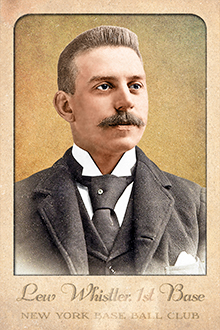
- Series: Pioneer Portraits II: 1875-1899
- City: New York
- Team: Giants
- League: National League
Lewis W. Whistler, nee Wissler, (1868-1959) played four years in the majors beginning with the Giants in 1890-91. He played for Baltimore and Louisville in ‘92 before concluding his stint in the big leagues with the Colonels and Browns in 1893. Lew was primarily a first-baseman but saw duty at short and outfield. Over the four years he batted .244 with 133 RBI and a dozen dingers. According to Baseball-Reference, Whistler had a career .976 fielding percentage at first base, ranking him with Cap Anson, Dan Brouthers, Joe Start and Harry Stovey albeit over a much shorter term. Lew had come into the minors in 1887 with the Wichita Braves of the Western League and hit .320 in 25 games. The following year saw him with four Texas clubs where he couldn’t hit much at all. A good season with the Senators in the Atlantic Association launched him to New York.
- Whistler played sporadically for a dozen teams in six minor leagues following his time with the Browns. He ended his pro career in the Southern League playing for two teams: the Montgomery Black Sox and Memphis Egyptians from 1903-05
- Series: Pioneer Portraits II: 1875-1899
- City: Buffalo
- Team: Bisons
- League: National League
- Hall: National Baseball Hall of Fame
James Laurie “Deacon” White (1847-1939). Considered the greatest catcher of baseball’s barehanded period (1870s), White eventually moved to 3rd base, played 23 seasons, won 6 championships, and played with a number of the century’s best players on a number of the century’s best teams.
- 1st person to bat in 1st pro league, in 1871, earning a hit – a double
- Reportedly believed the earth is flat
- 2 batting titles; 3 RBI titles
- Elected to Hall of Fame: 2013
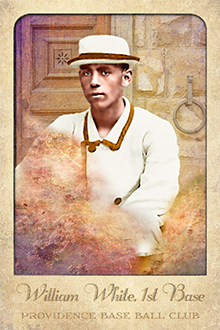
- Series: Pioneer Portraits II: 1875-1899
- City: Providence
- Team: Grays (NL)
- League: National League
William Edward White (1860-1937) has been declared by the researchers at SABR to be the most likely “first black player” in major league baseball. White, the son of a Georgia merchant and his slave, played on the Brown University team and, on June 21, 1879, substituted for an injured Joe Start at first base for the Providence Grays. White’s stint in the big leagues for this National League squad lasted only that summer solstice. With his Brown teammates cheering from the stands, White went 1-for-4, stole two bases, scored a run and recorded 12 putouts without an error, drawing rave reviews from the local papers and contributing to a 5-3 win for the title-bound Grays and a 19 year old pitcher named John Montgomery Ward. Despite the Providence Journal reporting that White would continue to play first base for the team's next series against Boston, he was replaced by regular right fielder and Hall of Famer Jim O’Rourke, who continued to man the position until Start returned. White then stepped back into society where he passed for Caucasian. This is borne out by census records showing he claimed Rhode Island birth and being of white race.
- It has been suggested that White had always passed as white, thereby escaping suspicion in the baseball world and dodging "the virulent racism prevalent in the late 19th century." This may explain in part why the true identity of the first black ballplayer in major league baseball history went largely unknown for about 125 years.
- It is likely that White is the only former slave to play major league baseball.
- White’s death resulted from a fall on Chicago’s ice. His death certificate shows him to be Caucasian, affirming this mixed-race man spent a lifetime seeking to avoid the stigma of being black in Jim Crow America.
- Series: Pioneer Portraits II: 1875-1899
- City: Boston
- Team: Beaneaters
- League: National League
James Evans Whitney (1857-1891) was a RHP with the Beaneaters who still ranks 4th in Atlanta franchise history in ERA. “Grasshopper Jim” played 10 seasons for 5 teams, ending his career in 1890 with the Athletics. Incredibly, he led the league in BOTH wins and losses (31-33) in his rookie campaign, leading Boston to the title.
- Was NL strikeout champ in 1883
- In 1884 he achieved a rare SO to Walk ratio of 10:1 (270-27)
- Series: Pioneer Portraits II: 1875-1899
- City: Chicago
- Team: White Stockings
- League: National League
Edward Nagle Williamson (1857-1894). A 3rd baseman & shortstop for 3 teams over 13 seasons, Ned was an above average hitter & excellent defender (despite his portly physique). Ned held the single season HR record (27 in ’84) until topped by Ruth’s 29 in ’19. Ned’s career was shortened by a knee injury he sustained while participating in Al Spalding’s baseball world tour.
In 1894, the Reach Guide convened a panel of 11 former ballplayers, including HOFer Jim O'Rourke, to debate who was the greatest baseball player of all time. The panel concluded that the honor belonged to Ned Williamson. Cap Anson himself called Ned "the greatest all-around ballplayer the country ever saw."
- Won 5 NL pennants
- Played in two World Series
- Once owned single season doubles record: 49
- Series: Pioneer Portraits II: 1875-1899
- City: Boston
- Team: Beaneaters
- League: National League
- Hall: National Baseball Hall of Fame
Victor Gazaway Willis (1876-1947) pitched for the Beaneaters, Pirates and Cards over a 13-year career. The “Delaware Peach” was renowned for finishing his starts (388 of 471.) Willis won 22 of the Pirates’ 110 victories in 1909, leading his team to the World Series against Ty Cobb’s Tigers.
- Still holds the NL (modern) record for complete games: 45 in 1902
- Hurled his only no-hitter in 1899 (the last of the 19th Century)
- Elected to Hall of Fame: 1995
- Series: Pioneer Portraits II: 1875-1899
- City: Cincinnati
- Team: Reds (NL)
- League: National League
Samuel Wright Jr. (1848-1928) has two brothers in the Hall of Fame: Harry and George. Alas, Sam’s .168 BA in 45 games over 4 seasons did not qualify him. Sam broke in with the New Haven Elm Citys of the NAPBP, considered by some a major league. Their 7-40 record led to their demise after one year.
- The Wright brothers’ father Sam was a prominent cricketer
- In Sam’s debut, he got a hit against brother Harry’s Red Stockings before being shellacked
- Series: Pioneer Portraits II: 1875-1899
- City: Cleveland
- Team: Spiders
- League: National League
- Hall: National Baseball Hall of Fame
Denton True Young (1867-1955) embodied excellence among ML pitchers. Baseball waited one year after his death to establish the award for annual greatness in his honor. Young’s 511 wins are still the hallmark. In 19 of his 21 seasons, he was in the top 10 in innings pitched. With Nap Lajoie, Young gave the upstart AL credibility when he jumped to the new circuit in 1901.
- In his 30s & 40s, led Boston’s Red Sox to 192 victories
- Pitched the 1st perfect game from 60’6”, beating Rube Waddell on 5/5/04
- Elected to Hall of Fame: 1937
- Series: Pioneer Portraits II: 1875-1899
- League: National League
Nicholas Ephraim Young (1840-1916) shepherded the National League from its inception in 1876 until the strains of dealing with the upstart AL caused his departure in 1902. Young was president from 1885-1902. Led the “Senior Circuit” during tumultuous years of job actions (the Players’ League), merger with the American Association in 1892, and the arrival of the competing American League.
- A former cricket player & government official, Young played amateur ball in Washington D.C.
- Organized the meeting that established the first pro league (Nat’l Assoc of Pro BB Players)
- His struggle to survive as NL leader against Al Spalding’s bid led to a compromise choice: Harry Pulliam
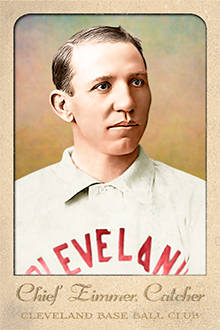
- Series: Pioneer Portraits II: 1875-1899
- City: Cleveland
- Team: Spiders
- League: National League
Charles Louis Zimmer (1860-1949) was one of the great catchers the game has known. As Cy Young’s receiver from 1890-98, Chief was extolled by the great pitcher as a peerless partner. The two grew up together with Cleveland with Zimmer setting numerous records at his position while guiding the nascent talent that would come to define baseball greatness. Perhaps fittingly, when Young left Cleveland after the ‘98 season, the club let the 38-year-old Zimmer go, too. He was spared the indignity of laboring for next year’s “worst team in history” club that went 20-134. Chief went on to a pennant with Pittsburgh in 1901, catching HOF’er Jack Chesbro. In ‘03 Pirate owner Barney Dreyfuss persuaded Zimmer to move to Philadelphia to manage the Phillies before retiring at 42.
- Zimmer claimed no Native American heritage. The “Chief” was due to being the team leader on an early club so speedy as to be dubbed “Indians”
- The Sporting Life wrote in 1890 that Zimmer was one of about 6 major leaguers who abstained from both liquor and tobacco. Despite his aversion to smoking, Zimmer made a fortune selling cigars, spreading his business to every city his ball club visited
- Was elected 1st president of The Players’ Protective Association – predecessor to the MLB Players’ Association
- An entrepreneur and wise investor, Zimmer was known to be one of the wealthiest players of his day
- Zimmer famously invented Zimmer’s Base Ball Game, a mechanical parlor game popular in the 1890s

